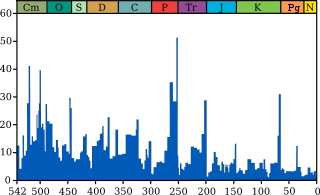End-Botomian mass extinction
The Botomian age of the Early Cambrian epoch lasted from ca 524 to ca 517 million years ago. At the end of the Botomian age there was a mass extinction that wiped out a high percentage of the organisms for which fossils were found. Organisms which produced small shelly fossils were almost exterminated.[1]
Notes
- ↑ Porter, S.M. (May 2004). "Halkieriids in Middle Cambrian Phosphatic Limestones from Australia". Journal of Paleontology. 78 (3): 574–590. doi:10.1666/0022-3360(2004)078<0574:HIMCPL>2.0.CO;2. Retrieved 2008-08-01.
External links
This article is issued from Wikipedia - version of the 11/28/2016. The text is available under the Creative Commons Attribution/Share Alike but additional terms may apply for the media files.
